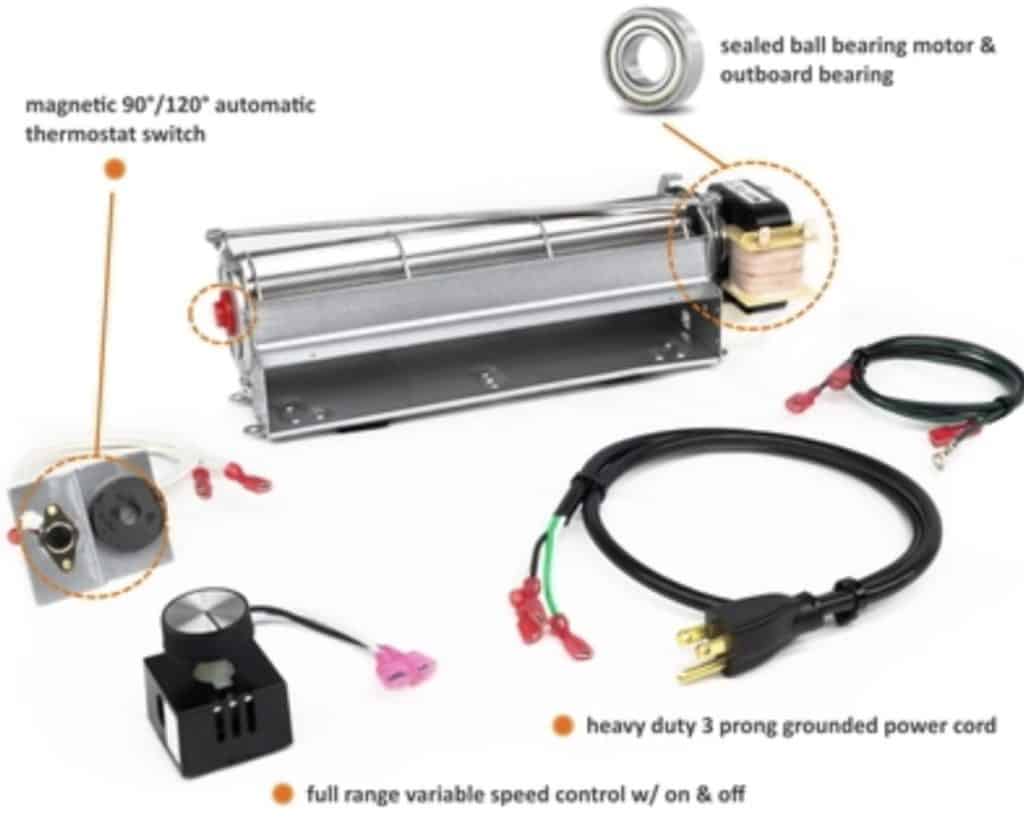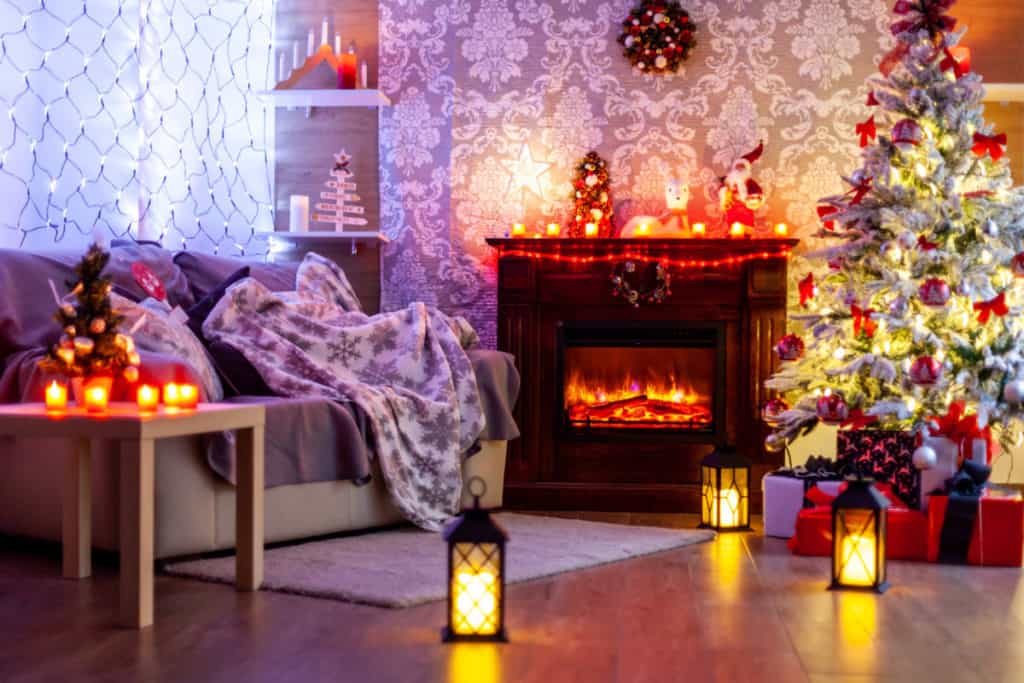A fireplace is a great centerpiece of any room. It brings a certain ambiance into your home, and it serves practical use, too. In the colder months, the heat from your gas fireplace is very welcomed. However, what happens when it is not heating your room adequately? What can you do?
A decorative gas fireplace does not have a built-in fireplace blower. When your gas fireplace is not heating your room, you need to look at installing a blower to circulate the heat. Other factors, such as fireplace dampers, backs, and doors, could prevent the heat from entering the room.
You want to get the most out of your gas fireplace, and this includes heat. Read on to discover why your gas fireplace is not heating your room, how to easily install a fireplace blower, and more.
When a Gas Fireplace Does Not Heat the Room
A gas fireplace is a beneficial addition to your home. A decorative gas fireplace can make any room feel cozy. However, when your gas fireplace does not heat the room, it becomes less useful.
While your gas fireplace is not your sole heat source, it definitely helps in the colder months. If your fireplace is not heating your room, you need to consider a few issues causing the gas fireplace not to work correctly.
Here is a list of issues that may cause your gas fireplace not to produce heat:
- Fireplace blower. Decorative gas fireplaces do not come with a built-in fireplace blower. Fireplace blowers move the hot air into the room and can easily be installed on your own. This is the best method to get heat out of your fireplace!
- Insulation. When your fireplace was installed, it should have been properly insulated. Sometimes the insulation is not strong enough, or it was not correctly installed. It is essential to check the insulation to make sure you are not losing heat unnecessarily.
- The fireback. If your fireplace does not have a fireback installed, it could cause the fireplace not properly heating your room. A fireback helps refect extra heat into the room rather than escape to the outside.
Regardless of the issue, it is important to weigh all your options. The most common one is the lack of a fireplace blower. This is usually an easy installation that you can do.
A Fireplace Blower Can Help
Most decorative gas fireplaces do not come equipped with a fireplace blower. However, these can be installed on your own with a few simple instructions.
But what is a fireplace blower?
A fireplace blower is a specific electric fan installed under a fireplace. It does not generate heat but effectively moves the hot air into the room. The blower fan can efficiently disperse the heat generated by the gas fireplace into the room.
Simply put, the fan circulating cold room air around the hot fireplace before pushing it back into the room. The result is a steady cycle of warm air that heats your space!
A fireplace blower can help get the most out of the gas fireplace. So, how do you install one yourself?
Understanding a Fireplace Blower
Before you order a fireplace blower, let’s go over its parts and how it works.
A typical gas fireplace blower fan is shaped like a cylinder and has an electric plug. The fan speed has a controller (more speed means more hot air blown into the room and more noise). A thermostat sensor automatically turns the fan on when the fireplace heats to a specific temperature and turns it off when it cools down.

How to Install a Fireplace Blower
Installing a fireplace blower will help heat the entire room and only requires a handful of steps.
Before you start, be sure to get the proper fireplace blower for the dimensions of your fireplace. Check this highly-rated blower on Amazon that comes in multiple sizes. Make sure you get the one with the most efficiency for the space you have.
- First, remove the fireplace insert. Make sure the fireplace off and cool before you start. Look for a knock-out plate at the bottom of the fireplace that can be removed. Most can be popped out without the need to remove any screws.
- Second, you will need to set up the wiring for the blower. Luckily, most fireplaces already have an electric plug installed under them. If yours does not have one, thread a 110/120 VAC service wire from the control box to the blower opening. Secure the wire with the blower clamp.
- Third, you need to clean the area thoroughly. There can be a build-up of dust and dirt in this area. Using a vacuum and a brush, make sure to remove all of it so that the area is as clean as it can be.
- Fourth, plug in or connect the motor. For fireplaces with an available electric outlet, just plug in the fan. Otherwise, you will need to connect the wires of the fan motor to the unit. Black connects with black; white connects with white, and the ground wire connects with the ground stud.
- Fifth, put the blower in place. You want the blower in the back of the fireplace but about ¼ of an inch from the back. Make sure it is secure with brackets. If it is loose, it can vibrate and make a sound. Magnets are another great way to secure the blower in place.
- Attach the thermometer sensor to the bottom of the fireplace. Most sensors are magnetic and will latch right onto the underside of your fireplace. For best results, place it directly below where the flames rise.
- Adjust the speed of your blower fan. Now turn on the fireplace and wait for the temperature to rise high enough to trigger the blower fan. Once the fan is on, adjust the speed (and thus the heat and noise) to your liking.
Once you have installed the blower, you can reconnect the power to the fireplace. You may now replace the knock-out plate.
Safety and Peace of Mind
As with any room with flames, a carbon monoxide detector is a must. Choose one with a battery, so it runs even when the power is out (here is how to run your gas fireplace, including the blower fan even when the power is out!). Here is an excellent choice from Amazon.
How to Get the Most from Your Fireplace
When your gas fireplace is not heating your room, you may worry. If you have already installed the fireplace blower, but you think your room is still not being heated the way you think it should, it could be something else affecting its performance.
Sometimes it has to do with the fireplace, but other factors can affect how a room is heated that do not have to do with the fireplace itself.
You will want to look at all these elements to decide what the issue is. It is best to try one at a time and take note of the results. Some possible methods you can use to get the most from your fireplace and to improve the heat output include:
- Install a fireback
- Use ceramic glass for the fireplace doors
- Check the insulation
- Prepare the room
- Get your fireplace inspected
- Keep your fireplace clean
If you troubleshoot your issue with these methods, you will find something that works for you. Additionally, it is a good idea to be consistent with how you operate your gas fireplace. While it is a great decorative piece, it can also serve as a heating source.

Install a Fireback
A fireback is a great way to improve the heating quality of your gas fireplace. You may have seen a fireback before but did not know what it was.
A fireback is a large piece of iron or steel that is installed on the back wall of your fireplace. They can be decorative, with elaborate designs, and they can be just solid metal. The decision is an aesthetic one.
Regardless, they will help keep your room warmer. They do this by reflecting the heat from the fireplace into the room. The walls of your fireplace can let a lot of heat escape. This can be part of the reason your room does not feel like it is being heated properly.
By installing a fireback, you are preventing the loss of heat. Additionally, the heat that would normally escape through the back of the fireplace will now be reflected toward the front of your fireplace and into your room.
Use Ceramic Glass for the Fireplace Doors
At the front of your fireplace, there are doors. These doors are usually made from regular glass, which does not help intensify the fireplace’s heat.
Consider replacing the glass doors with ceramic glass. Ceramic glass is efficient at transmitting the heat from the fireplace and into the room. Ceramic glass is durable and great at helping move all that warm air to where it matters most.
Additionally, the ceramic glass is still clear, so you do not have to worry about not seeing the aesthetic qualities of the fire.
Check the Insulation
As mentioned earlier, the insulation around the fireplace is crucial to maintaining the effectiveness of your gas fireplace.
Poorly installed insulation can cause a lot of heat to escape before it ever reaches your room. You do not want this to happen. You want to make sure the insulation is installed correctly to ensure maximum fireplace efficiency.
The most important places for your gas fireplace to be insulated are around the door and the exterior wall of the fireplace. Proper insulation will help retain heat from escaping into the walls or outside.
Moreover, proper insulation will allow the heat to be funneled through the front of the fireplace and into your room. Good insulation paired with a fireplace blower, a fireback, and ceramic doors can make a big difference in how warm your room gets.
Preparing the Room
Sometimes the problem is not with your gas fireplace. The issue may reside in the room. For example, if a window is open, then heat will inevitably escape through it.
You can make some preparations for your room to make it ideal for retaining the fireplace’s heat. These include:
- Close windows. As mentioned, closing all the windows will help retain heat in your room. When you open a window, you are not only letting hot air escape, but you are also letting cold air in. For best results, make sure the windows are closed and securely locked.
- Close doors. If you can, make sure doors are closed, too. If your room has a door going outside, it is essential to keep this closed for the same reasons as the windows. You do not want any heat to escape your room.
- Use the ceiling fan. This may seem counterintuitive. However, if you use your ceiling fan in reverse, it can help circulate the warm air in the room by pushing it up and out.
Using these simple methods ensures that you will get the most out of the heat coming from your gas fireplace.
Get it Inspected
Maintaining your gas fireplace is an important factor in making sure it continues to heat your home. It may be that your fireplace has not been inspected in a while. Over time, as with any appliance, the effectiveness can diminish.
However, if you get your gas fireplace inspected at least once a year, you will be able to avoid a lot of the effects of time. Additionally, if you get it inspected, you will be able to catch any issues when they are still minor.
An inspection will ensure that your gas fireplace is:
- Ventilating properly
- Heating properly
- Up to standard
If there is a heating problem, the inspector will know exactly where to look and be able to advise you on your next steps. Getting your gas fireplace inspected is part of the normal upkeep required to keep it in top operating condition.
Keep Your Fireplace Clean
While gas fireplaces work differently than their traditional counterparts, this does not mean that they do not still get dirty. Part of your yearly maintenance should be keeping your fireplace clean.
Dust can accumulate and cause damage and issues to occur within the fireplace. The same is true for dirt and debris. You should regularly check to make sure your fireplace is clean.
By keeping it clean, you are making sure it will work properly and efficiently. A clean fireplace will work much more effectively than a dirty one and will be able to produce more heat for your room.
Understanding Your Gas Fireplace
Of course, there are other reasons why your gas fireplace may not be heating your room. Understanding your gas fireplace is important so that you may troubleshoot the issue effectively.
Placement of Your Fireplace
The placement of your fireplace can also have a significant impact on how your room is heated. For example, if your gas fireplace is located in one corner of the room, it will have a more difficult job heating the opposite corner.
If you are getting a gas fireplace installed in your home, you need to place it strategically. A vent-free fireplace does not have the same restrictions as vented ones. They do not require being next to a wall to work.
Regardless, you want to take the dimensions and the layout of the room into account. It is best to keep the fireplace away from windows as windows can suck the heat away from the room.
Moreover, you may not have installed the fireplace yourself. This is okay. There are other ways to get the most out of your gas fireplace without having to move it.
The Fireplace Dampers
Gas fireplaces are not usually synonymous with fireplace dampers. Dampers are typically found on traditional fireplaces, but this does not mean they do not exist for gas ones. This is because dampers work to help vent toxins and gasses from regular fireplaces. Gas fireplaces have their own vents.
If you have dampers installed with your gas fireplace, they could be part of the reason that your room is not heated.
Consider that when you have installed dampers with your gas fireplace that they can help retain heat within the room. However, if you have the dampers too wide, the flames of the gas fireplace can be diminished. When the flames are diminished, it results in less heat being generated and pushed into the room.
Conclusion
A gas fireplace is a great decorative piece for any room in your house. Yet, they do not have to be only decorative. They can heat your room nicely. However, sometimes you may feel that it is not heating your room enough.
By installing a fireplace blower, changing the fireplace doors to ceramic glass, using the dampers, preparing your room properly, installing a fireback, and maintaining the fireplace itself throughout the year, you ensure that you will get the most out of it.
Installing a fireplace blower or a fireback is not difficult and can go a long way in improving the quality of the heat. Moreover, these methods are simple and, when implemented, can make a huge difference. Once your gas fireplace emits more heat, you will be able to enjoy it even more.
Can I Run My Gas Fireplace Run During a Power Outage?
Now that you know what it takes for a gas fireplace to heat your room, you can go a step further and make sure it runs when the power is out. Become a SecureHomeHero and keep your family warm even when the power is out! Check my article here.

